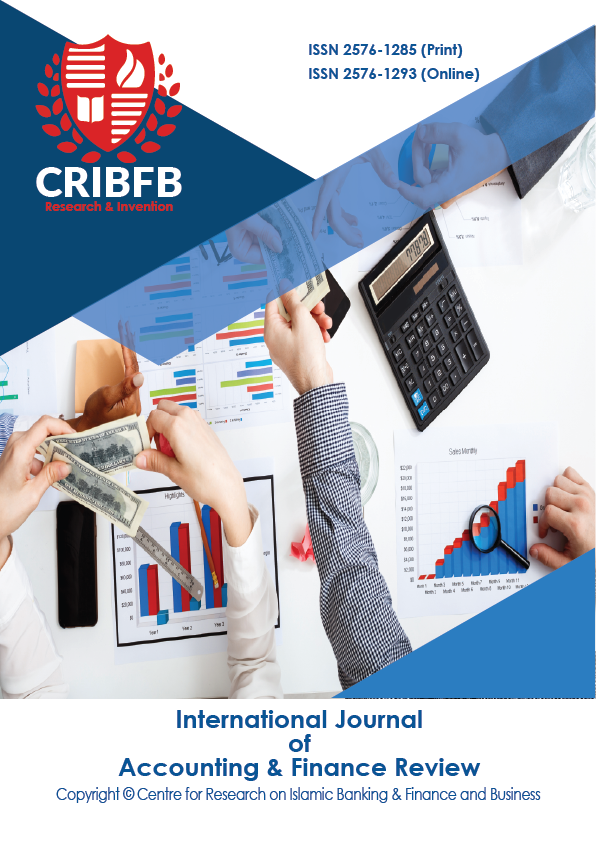THE STIMULUS OF MICROFINANCE INSTITUTIONS FINANCIAL SELF RELIANCE IN BANGLADESH: A PANEL DATA ANALYSIS
Main Article Content
Abstract
Microfinance is the concession of providing comprehensive financial services to unbaked rural people. It has become an empirically proven tool to fight against rural poverty in developing countries like Bangladesh. The performance of MFIs in the improvement procedure of an economy is impressive. In this study, researchers purposively select sixty (60) microfinance institutions as a sample and incorporate five years of panel data from 2015 to 2019. Researchers use return on assets (ROA) as a proxy of financial self-reliance, whereas size, experience, managerial efficiency, the breath of outreach, and depth of outreach are explanatory variables. For analyzing data, researchers employ Stata 12 software, and ordinary least square and fixed effect models are also used for assessing the stimulus of MFIs' financial self-reliance. The study revealed that size, experience, managerial efficiency, the breath of outreach & depth of outreach are explained by 73.75% variation of the dependent variable, i.e., financial self-reliance of MFIs in Bangladesh, which is statistically significant at a 1% level. Researchers outlined that size, experience, managerial efficiency, breadth of outreach, and depth of outreach are this study's statistically substantial stimulus for sample MFIs.
JEL Classification Codes: G21, C23.
Downloads
Article Details
Section
How to Cite
References
Ayayi, A. G., & Sene, M. (2010). What drives microfinance institution's financial sustainability? The Journal of Developing Areas, 303-324. Retrieved from https://www.jstor.org/stable/41428207
Al Atoom, R. O., & Abu Zerr, A. E. (2012). Macro and microfinancial factors that assures Jordanian Microfinance Institutions'(MFIs) financial sustainability. European Journal of Economics, Finance and Administrative Sciences, 54, 146-160. Retrieved from https://www.europeanjournalofeconomicsfinanceandadministrativesciences.com/issues/EJEFAS_54.html
ADHIKARY, S., & PAPACHRISTOU, G. (2017). Determinants of profitability in south Asian microfinance institutions. Journal of Global Economics, Management & Business Research, 8, 76-87. Retrieved from https://www.ikppress.org/index.php/JGEMBR/article/view/3247
Abdishakur, K. (2020). The Determinants of Profitability (Evidence from MFIs in Addis Ababa) (Doctoral dissertation, ST. MARY’S UNIVERSITY). Retrieved from http://repository.smuc.edu.et/handle/123456789/5669
Dunford, C. (2003). The holy grail of microfinance: ‘Helping the poor’ and ‘sustainable’? 11(1), 40-44. https://doi.org/10.3362/0957-1329.2000.008
Dissanayake, D. M. N. S. W. (2012). The Determinants of Microfinance Profitability: Evidences From Sri Lankan Microfinance Institutions. Kelaniya Journal of Management, 1(1), 50-67.
Gaul, S. (2011). Defining responsible financial performance: the role of profits, Micro-banking bulletin, May 2011
Hollis, A., & Sweetman, A. (1998). Microcredit: What can we learn from the past?. World Development, 26(10), 1875-1891. https://doi.org/10.1016/S0305-750X(98)00082-5
Hossain, M. S., & Khan, M. A. (2016). Financial sustainability of microfinance institutions (MFIs) of Bangladesh. Developing Country Studies, 6(6), 69-78. Retrieved from https://www.iiste.org/Journals/index.php/DCS/article/view/31113
Janda, K., & Turbat, B. (2013). Determinants of the financial performance of microfinance institutions in Central Asia. Post-Communist Economies, 25(4), 557-568. https://doi.org/10.1080/14631377.2013.844935
Kyereboah-Coleman, A., & Osei, K. A. (2008). Outreach and profitability of microfinance institutions: the role of governance. Journal of Economic Studies, 35(3), 236-248. https://doi.org/10.1108/01443580810887797
Khan, Z. A., Butt, S., & Khan, A. A. (2017). Determinants of financial self sufficiency in microfinance institutions: a study of Pakistan, India and Bangladesh. European Online Journal of Natural and Social Sciences, 6(2), 296-301. Retrieved from https://european-science.com/eojnss/article/view/4919
Loan, P. N. T., & Huy, N. T. (2015). FINANCIAL PERFORMANCE AND OUTREACH OF MICROFINANCE. Asian Journal for Poverty Studies, 1(1), 52-60. Retrieved from http://repository.unib.ac.id/id/eprint/10629
Morduch, J. (1999). The microfinance promise. Journal of economic literature, 37(4), 1569-1614. https://doi.org/10.1257/jel.37.4.1569
Muriu, P. (2012). What explains the low profitability of microfinance institutions in Africa?. African Journal of Social Sciences, 2(3), 85-115. Retrieved from https://drive.google.com/file/d/1SyQK6wxoz11rL2Yo9jxDui0NNMBTcRHQ/view
Parvin, S. S., Hossain, B., Mohiuddin, M., & Cao, Q. (2020). Capital structure, financial performance, and sustainability of micro-finance institutions (MFIs) in Bangladesh. Sustainability, 12(15), 6222. https://doi.org/10.3390/su12156222
Rahman, M. A., & Mazlan, A. R. (2014). Determinants of financial sustainability of microfinance institutions in Bangladesh. International Journal of Economics and Finance, 6(9), 107-116. https://doi.org/10.5539/ijef.v6n9p107
Schreiner, M. (2000). Ways donors can help the evolution of sustainable microfinance organizations Savings and Development, 24(4), 423-437. Retrieved from https://www.jstor.org/stable/25830741




